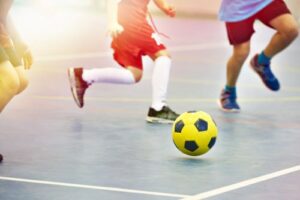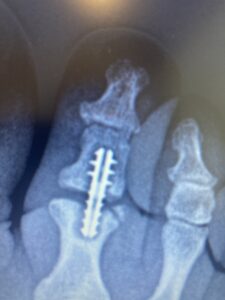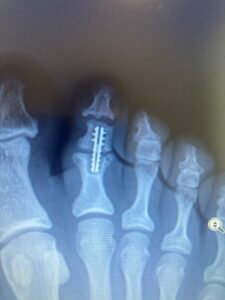
As kids head back to school, excitement often comes with increased physical activity, whether through sports, recess, or simple playground fun. However, this surge in activity can also lead to common foot and ankle injuries, many of which are specific to growing children.
Understanding these injuries and knowing how to prevent and treat them is crucial to keeping your child healthy and active. Below are the most common podiatric injuries parents should be aware of as their kids return to school.
Fracture of the Growth Plate
Growth plates are the softer areas of cartilage located at the ends of long bones in growing children. These plates determine the future length and shape of bones, making them vulnerable to fractures.
A growth plate fracture occurs when the bone is subjected to excessive force, which can happen during falls, sports, or other physical activities.
- Symptoms: Swelling, pain, and difficulty moving the affected limb are common signs.
- Diagnosis & Treatment: X-rays are typically needed to confirm the fracture. Treatment often involves immobilization with a cast or splint. In severe cases, surgical intervention may be necessary to ensure proper healing and to prevent future growth disturbances.
Because the growth plate controls bone development, untreated fractures can lead to uneven bone growth or deformities. Early diagnosis is essential to avoid long-term complications.
Inflammation of the Growth Plate: Severs Disease
One of the most common causes of heel pain in children is Severs Disease, also known as calcaneal apophysitis. This condition involves inflammation of the growth plate in the heel, often caused by repetitive stress and strain from running and jumping.
- Risk Factors: Severs Disease primarily affects children during growth spurts, typically between the ages of 8 and 14, especially those involved in high-impact sports like soccer, basketball, or track.
- Symptoms: Pain at the back of the heel, which may worsen with activity and improve with rest, is a key symptom.
- Treatment: Rest, ice, and over-the-counter anti-inflammatory medications are effective. Physical therapy exercises may also be recommended to strengthen the muscles and tendons around the heel.
Proper footwear with good arch support and cushioning is crucial in preventing Severs Disease from recurring.
Ligament Sprains
Ligament sprains are a frequent occurrence in children, particularly as they return to school sports. Ligaments are bands of tissue that connect bones and provide stability to the joints.
When a ligament is overstretched or torn, a sprain occurs.
Ankle Ligament Sprains
Ankle sprains are among the most common injuries in active children, often resulting from a twist or turn of the foot during sports.
- Symptoms: Swelling, bruising, and a loss of range of motion are common signs of an ankle sprain.
- Treatment: Rest, Ice, Compression, and Elevation (R.I.C.E.) is the first step in managing an ankle sprain. More severe sprains may require physical therapy or the use of a brace to promote healing and prevent re-injury.
Midfoot Ligament Sprains
While less common than ankle sprains, midfoot sprains can occur due to falls, trips, or direct impact injuries.
- Symptoms: Pain, swelling, and tenderness in the middle of the foot are typical symptoms.
- Treatment: Like ankle sprains, midfoot sprains respond well to R.I.C.E. and, in some cases, immobilization with a cast or boot may be necessary for proper healing.
Preventing ligament sprains involves proper warm-up routines before physical activities, supportive footwear, and strengthening exercises to maintain joint stability.
Turf Toe
Turf toe is a sprain of the main joint of the big toe, often caused by excessive upward bending during sports like football, soccer, or basketball. It occurs when the toe is forcibly jammed or bent beyond its normal range of motion.
- Symptoms: Pain, swelling, and limited movement at the base of the big toe are typical.
- Treatment: Rest, icing, and taping the toe can alleviate the symptoms. In severe cases, immobilization may be required to allow the joint to heal properly.
Wearing stiff-soled shoes and using orthotic inserts can prevent turf toe by limiting the range of motion of the big toe.
Sesamoiditis
The sesamoid bones are two small bones located beneath the big toe that help absorb the impact of walking and running. When these bones become irritated or inflamed due to repetitive pressure, it leads to sesamoiditis.
- Symptoms: Pain beneath the big toe, especially when pushing off during walking or running, is the primary symptom.
- Treatment: Reducing activity, icing the affected area, and using custom orthotic inserts can relieve pressure on the sesamoid bones. In chronic cases, a podiatrist may recommend physical therapy or even surgery.
Tendonitis
Tendonitis refers to inflammation of the tendons, the thick cords that connect muscle to bone. In children, the most commonly affected tendons are the Achilles tendon and the tendons on the outside of the ankle (peroneal tendons).
- Symptoms: Pain, swelling, and tenderness along the affected tendon, particularly with activity.
- Treatment: Rest, stretching exercises, and physical therapy are typically recommended. Orthotic devices can also help alleviate stress on the tendons.
Encouraging proper stretching before physical activity can reduce the risk of developing tendonitis.
Subungual Hematoma
A subungual hematoma occurs when blood collects under a toenail, often caused by a heavy object falling on the toe or repetitive trauma from activities like running or playing sports.
- Symptoms: Intense pain, throbbing, and a visible dark spot beneath the nail.
- Treatment: Small hematomas may heal on their own, but larger ones may require a podiatrist to drain the blood to relieve pressure and prevent complications.
Wearing properly fitted shoes with adequate toe protection can prevent subungual hematomas from occurring.
For Treatment of Injuries at School, Call Salt Lake City Podiatrist Dr. Elizabeth Auger, DPM
As children head back to school, they become more susceptible to various foot and ankle injuries due to increased physical activity. Recognizing these common podiatric conditions—ranging from growth plate fractures to tendonitis—can help parents take the necessary steps to ensure proper treatment and prevent long-term complications.
If your child complains of foot or ankle pain after a sports injury, consult with Dr. Elizabeth Auger for a comprehensive evaluation and treatment plan. Early intervention is key to keeping your child healthy, active, and pain-free throughout the school year. Call SLC Podiatrist today at (801) 845-3960.



